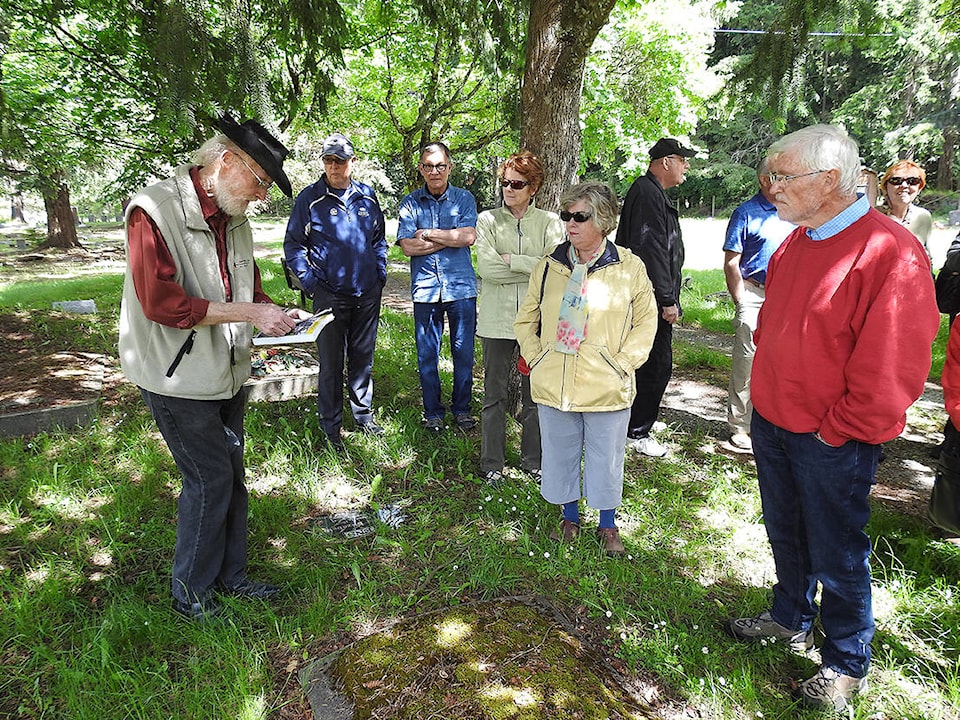Two weeks ago, I had the pleasure of guiding 20-odd members of the Newcomers Club through the Chemainus, St. Peter’s and St. Ann’s cemeteries. (Followed by an excellent dinner at Providence Farm, I might add.)
We visited more than 40 graves in four hours. Most I chose for their stories but some I pointed out for their elaborate (or poignant) headstones or for their heart-tugging inscriptions. Mostly I chose them for their stories and, as I’ve drawn to the attention of Chronicles readers before, some “tales the tombstones tell” are worthy of Hollywood movie scripts.
I told the Newcomers (some of whom, organiser Mike Wild told me), apparently stay with the club even after years of residence in the Cowichan Valley) of how Chemainus butcher Matthew Howe donated the land for a cemetery to replace the one on Kuper Island and how his wife became its first permanent resident.
I explained how the most prominent headstones, those of Japanese residents, have been reset together with a common memorial plaque explaining that the original graves were desecrated after Japan’s attack on Pearl Harbour.
I showed them the particularly poingnant headstone that’s marked, simply, “Jimmy Our Baby;” the distinctive six-foot-plus totem pole that denotes the grave of Michael Gleig; and those graves inscribed with the shield of the Woodsmen of the World. (Woodsmen doesn’t denotes forestry workers, by the way—it’s the name of an American fraternal organization that also provided insurance.)
For drama, I offered the Newcomers Richard Beaumont Halhead, provincial policeman who led the manhunt for a murderer on Mount Sicker; Joseph R. Burkitt, who was “lost at sea near Tasmania” in December 1914, and Clifford Syme, 27, shot for a deer on the first day of hunting in 1926. (He had brown hair and wasn’t wearing a hat.)
That was the Chemainus Cemetery. Our next stop was St. Peter’s, Quamichan, which is worthy of a tour of its own. As a bonus, Priscilla Lowe, church historian, guided us through the beautiful and historic structure while pointing out and explaining various features and memorials.
That done, we trooped outside to view the massive stone that was hauled by horse and stoneboat to serve as a memorial to the church’s fallen parishioners of both world wars. I spoke of the Maitland-Dougall brothers, Hamish and William, and the Hoeys, Charles and Trevor; heroes all, Charles the Valley’s sole winner of the Victoria Cross, the highest award for gallantry in the British Commonwealth.
Then it was into the cemetery for a quick tour (we still had to visit St. Ann’s) of some of the most fascinating pioneers and elaborate headstones to be found on the Island. Here, my challenge as a guide was to cherry-pick graves, so rich is the choice of stories. I had to be content with sawmill owner Alfred Sutton, who was shot for a deer; Mary Marriner, who left us her priceless diaries; Able Seaman Austin Ordano who went down with the only Canadian naval ship lost in the First World War; father and son Clement and Vice Air Marshal Sir Philip Livingston who perfected night vision and helped to defeat the Luftwaffe; William C. and Sarah Annie Duncan, City of Duncan namesakes.
Jeremina Colvin, unofficial mother of the Cowichan sweater; the Pimbury brothers who gave us the beautiful but oh so invasive ox-eye daisy; James Charles Prevost Jr., whose fall from grace made newspaper headlines for weeks on end; Rev. William S. Reece who contributed to tearing a Victoria church congregation asunder; Victor V. Murphy, the Valley’s first automobile casualty (he was hit by a train).
There were others: the first non-native woman to be tried for murder in B.C.; Capt. Edward Barkley who died trying to save a priceless journal from fire; murderer and suicide Fred Beech who, for reasons lost to history, is interred in hallowed ground; and, perhaps the most famous of St. Peter’s residents, William Henry Dring and Charles Miller whose inscription informs us that they were “massacred,” Feb. 14, 1886, and once made Ripley’s Believe It Or Not.
Mike reminded me that we were slightly behind schedule—dinner was set for 5:30—so it was on to St. Ann’s, a look inside (a first for me, too), then a recital of some of this picturesque hillside cemetery’s more noteworthy graves. Again, I had to shortlist from dozens of noteworthy pioneers. Beginning, of course, with the man who founded the first two St. Ann’s churches, Father Peter Rondeault.
And that want ad for a hangman? I see I’m running late again so that’ll have to await another day!
www.twpaterson.com




